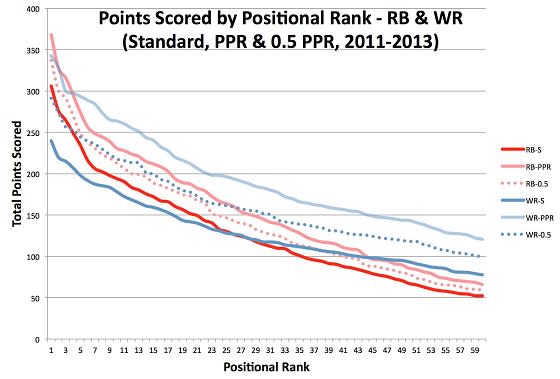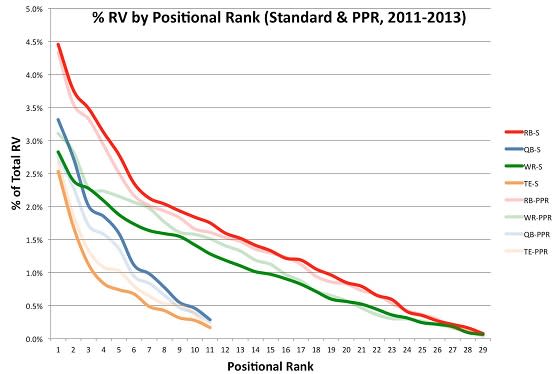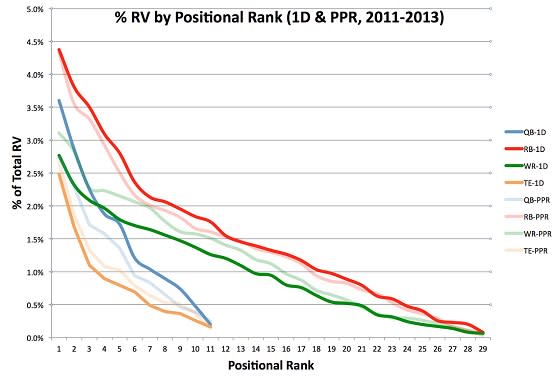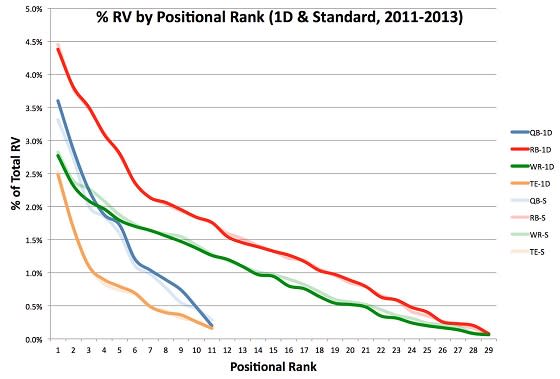To PPR or Not to PPR?
In the interests of full disclosure, I have been playing primarily in PPR (Point Per Reception) leagues for the last decade or so. I originally bought into the format since it enhanced the scoring of receivers and tight ends, and gave a better mix of positions in the top 30 (overall) in any given season. Those who say it’s boring when a 12-team draft begins with 16-straight running backs will get no argument from me. PPR certainly makes wide receivers and tight ends more attractive in the early rounds.
But as time has worn on, I find myself far less enamored with the scoring system. After losing a semifinal game by 0.2 points because of a zero-yard reception by a running back that accomplished absolutely nothing for his real-world team, I started to wonder, is PPR really doing what it was intended to do?
Then Julian Edelman happened. On September 12, 2013, Edelman caught 13 passes for 78 yards and zero touchdowns in a 13-10 win against the Jets. His 6.0 YPC average was the lowest of any wide receiver with at least 11 catches since 1960. Only three of his 13 catches actually moved the chains. He scored 21.2 fantasy points (he also had a 4-yard rush), which was the 16th-highest total of the week at his position in PPR formats. He scored more fantasy points than Darren McFadden, who gained 157 total yards, which was more than twice Edelman’s receiving yardage. He scored more fantasy points than Giovani Bernard, who gained 65 total yards and found the endzone TWICE. He scored more than Antonio Gates who caught eight balls for 124 yards.
This just doesn’t seem right.
Different people have different reasons for choosing a particular scoring system. I took to Twitter and posed the question — what is the primary purpose/function of a PPR scoring system? Generally speaking, the responses fell into five categories:
1. To increase the number of fantasy-relevant players.
Examples:
“To make more players fantasy relevant which also creates deeper leagues.”
“I think it helps make more players viable starting options, especially in larger leagues.”
2. To shift fantasy value from RB to WR and TE.
“I would say to level playing field of RBs a bit, also devalues QBs as result.”
“Rewards players. RBs that can catch the ball > RBs that can't catch.”
“I think the original reason was to increase the value of WR (and TE a little) in relation to RB.”
“The NFL is a passing league and standard scoring weighs RB value too highly.”
“Originally, it was to balance RB/WR values. Not sure it achieves that anymore, tho. Hence the proliferation of PP1D.” (PP1D = Point Per First Down; we’ll cover that later.)
3. To reduce the impact of touchdowns, which are less predictable than yardage and receptions.
“Take luck out of the game a bit. Scoring often times luck vs number of receptions.”
“To mitigate TD's. The standard system is too TD-centric.”
“Puts less emphasis on TDs and more emphasis on categories that carry less variance, thus more predictable and more game of skill.”
4. To reward real-world value.
“To give value to WRs that consistently move the chains. In real football 5 receptions for 50 yds is good, but not in standard FF.”
“Isolates and rewards the singular essential purpose-fulfilling act of being a receiver of the passed ball: the reception.”
“To both further reward volume-heavy WRs and 3-down RBs, and increase the total number of usable players in deeper leagues.”
“Increases quality of players. Guys like Sproles/Welker become top 24 while the Mike Wallace's drop in value.”
“Give points to those who had an impact on the game, example: catches a few yard catch but it gets a first down.”
5. To make things more fun and exciting.
“Simple: it makes it fun. I played in both last year and it's simply just more fun.”
“I think it's just an added scoring method to make it more exciting.”
I don’t take issue with argument #3, while #5 is subjective, so let’s discuss the other three points.
Does PPR increase the number of fantasy-relevant players?
The graph below plots positional ranking for RB and WR against total fantasy points scored in each system.

The dark lines indicate standard scoring for both positions, while the lighter and dotted lines represent PPR and 0.5 PPR scoring, respectively.
Depending on one’s definition of “fantasy-relevant,” it doesn’t appear that PPR scoring does much to enhance the value of the players outside of the top 40 at RB and WR since each set of lines are not diverging as we move down the rankings. While it’s true that it’s much easier to find a WR that has a chance to score 10+ fantasy points (i.e. five receptions for 50 yards) on the waiver wire, PPR proponents should keep in mind that every receiver in the league is getting a boost in points earned from receptions, so the whole curve is moving upwards.
Pass-catching RBs (i.e. Danny Woodhead, Darren Sproles and Jacquizz Rodgers) certainly become more startable in PPR, but we’re at the same time devaluing RBs who don’t catch a lot of passes. Players like LeGarrette Blount and BenJarvus Green-Ellis weren’t very startable in PPR formats, so in a way we’re robbing Peter to pay Paul.
A great example is Alfred Morris, who was 4th in the league in rushing and 12th in total yards from scrimmage. He was just the #20 RB in PPR formats since he only caught nine passes all year. So for every Danny Woodhead, there’s an Alfred Morris.
Does PPR shift value from RB to WR/TE?
The short answer is yes, but there are consequences. To study PPR’s impact on each position, I calculated the postseason Relative Value (RV) of each player using Value-Based Drafting (VBD) methodology for a starting lineup consisting of 1 QB, 2 RB, 2 WR, 1 TE and a flex. My baselines for each position were 12, 30, 30 and 12, respectively.
I then summed the RV of all the positive players (i.e. those above the baseline) from 2011 to 2013 and found the average % RV for each player at each positional ranking. For example, the end-of-year RB1 from 2011 to 2013 has had an average actual relative value of 4.5% in standard scoring formats with the aforementioned roster requirements.
Why use % RV as a measure of positional importance?
Relative Value allows us to compare a certain player’s value not only to his own position, but across all four primary fantasy positions. The “last starter” at each position has a RV of zero, so every other starter-worthy player has a positive RV. The player with the highest RV gives his owner the biggest advantage at his position, and is therefore the most valuable player in the league. The larger the share of RV that an owner can start throughout the season (and fantasy playoffs), the better their chances for a league title.
The graph below shows how the value of each position is affected by a PPR scoring system.

The standard plots are darker while the PPR are lighter. It’s clear that the RB is impacted negatively by PPR, but the two scoring systems converge around RB16. WR and TE both get a boost under PPR but the two WR plots converge around WR18.
So yes, PPR does shift some value from RB to WR and TE as was intended. But look at the two QB plots (in blue): PPR also devalues the quarterback position, which is the most important position in football. It barely holds more value than the TE position. Is this what we want in a scoring system?
Does PPR better reward real-world value?
When it comes to rewarding players who “move the chains,” who is more instrumental in getting a first down — the running back who runs for eight total yards on 1st and 2nd down or the receiver who catches a 3-yard pass on 3rd-and-2? In a PPR scoring system, the receiver would earn 1.3 points for that play, yet the back would only get 0.8 points for his eight yards. Is that fair? Sure, by catching the ball, the receiver kept the offense on the field, but they wouldn’t have been in position to get a first down if not for the eight yards of grunt work done on the first two plays of the series by the running back.
Remember, in the case of Julian Edelman’s now-infamous 13-catch day, he only gained three first downs, so PPR is sort of a shotgun approach at rewarding real-world accomplishments.
If the idea is to reward players who get first downs, why not scrap PPR and give a point (or a half-point) for every first down gained by the player? My Fantasy League has the ability to track and reward points for this statistic. Here’s a look:

For the 1D (first down) scoring system, I gave 0.5 points for every first down gained by all positions (including QB, both rushing and passing). Clearly, QB is the big winner here when compared to PPR, but RB also gets a bump.

When comparing first down scoring to standard formats, only QB gets a mildly significant boost (since we are adding first down passes to the mix), while the rest of the positions remain relatively unchanged. However, if predictability is a goal, adding first downs will smooth out the scoring since each player/team will be less dependent on touchdowns when scoring fantasy points.
CONCLUSION
To sum up…
If the primary goal of a PPR scoring system is to make more “fantasy-relevant” players, I don’t believe it’s succeeding. Sure, it’s inflating scoring so that more players score 10 or more points each week, but is that really making more players relevant if nearly everyone is getting a bump for reception scoring?
PPR does shift some value from RB to WR and TE, but it also deflates the most important position in football: the quarterback. As it stands, the position is so deep that owners can ignore it for the first half of the draft and still end up with a quality passer in the 8th or 9th round. There are strategies that revolve around streaming QBs from the waiver wire. While this is a valid strategy for one-QB PPR (and standard) format, given how important the position is in the NFL, shouldn’t fantasy football better reflect this importance?
PPR does a poor job of rewarding real-world value. Why should a player get a full point (equal to 10 rushing/receiving yards) for a catch that nets his team zero yards? If the goal is to reward players for moving the chains, then award a point or a half-point for each first down.
After going through this process, if I were starting a league, I would not use a PPR format. I think there are better ways to improve the balance between the positions and to reward on-field production. I’ll be back with a Part 2 of this scoring system study to discuss a few different options that commissioners and owners have to better balance positional value.
Update: Here is the link to Part 2.
